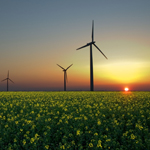
Principles of Sustainability
Chapter 6 - Energy Sustainability
Part 6 - Fossil Fuels: Natural Gas
 Natural gas is the cleanest burning fossil fuel. Historically it has been under utilized in the energy and transportation sectors compared to coal and oil. Natural gas can be shipped as compressed gas in pipelines and tank trucks, and it can be shipped in ocean tankers as liquefied natural gas. Natural gas developments have a smaller environmental impact than coal or oil, but the impacts to the environment from water pollution near drilling operations, especially "fracking or hydraulic fracturing" processes, are of increasing concern as natural gas production increases to meet increasing demand. Methane, the parent compound in natural gas, is modeled to have a 20-fold greater greenhouse gas capacity than carbon dioxide, thus leakage in production, transport, and distribution is of concern.
Natural gas is the cleanest burning fossil fuel. Historically it has been under utilized in the energy and transportation sectors compared to coal and oil. Natural gas can be shipped as compressed gas in pipelines and tank trucks, and it can be shipped in ocean tankers as liquefied natural gas. Natural gas developments have a smaller environmental impact than coal or oil, but the impacts to the environment from water pollution near drilling operations, especially "fracking or hydraulic fracturing" processes, are of increasing concern as natural gas production increases to meet increasing demand. Methane, the parent compound in natural gas, is modeled to have a 20-fold greater greenhouse gas capacity than carbon dioxide, thus leakage in production, transport, and distribution is of concern.
Many advocate natural gas as a "transition" fossil fuel, replacing coal and oil in energy generation. Abundant supplies and cleaner operations with significantly greater efficiency for energy generation, as well as the compatibility of natural gas with the current energy generation and electricity utility infrastructure and cost basis, are some of the drivers for enhanced use of natural gas.
Keywords
- Wet natural gas
- Dry natural gas
- Associated natural gas
- Unassociated natural gas
- Liquified natural gas
- Hydraulic fracturing; "fracking"
Suggested Reading
- Natural Gas Delivery and Storage Natural Gas Pipelines Liquefied Natural Gas Where Our Natural Gas Comes From Imports and Exports How Much Gas Is Left Use of Natural Gas Prices Factors Affecting Natural Gas Prices Natural Gas & the Environment Customer Choice Programs U.S. Energy Information Administration. U.S. Department of Energy.
- Statistical Review of World Energy - Natural Gas. BP
